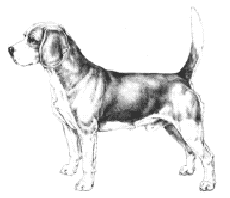Beagle
General Information - Beagle

Group:
Hound
Size:
Medium
Lifespan:
12-15 years
Exercise:
Medium
Grooming:
Very low
Trainability:
Low
Watchdog Ability:
High
Protection Ability:
Very low
Area of Origin:
England
Date of Origin:
1300s
Other Names:
None
Original Function:
Hunting hare on
foot
History
The Beagle was developed in England and is said to descend from the Talbot Hound brought there during the Norman Conquest (1066). The first written reference to the Beagle dates back to the 15th Century; the name is most likely derived from the Celtic word "beag" which means "small." The Beagle looks most like the Foxhound and is the smallest of the scent hounds. Its main prey when hunting is the hare in England and Cottontail rabbit in North America. Beagle field trials are extremely popular overseas for many sportspeople. The first beagles reported to be introduced in to New Zealand were imported in 1868 by Governor Sir George Grey.
Temperament
The Beagle has a cheerful, upbeat personality and is great with kids although at times a little too boisterous. Like all scent hounds, Beagles have retained their hunting instincts and are an independent breed, at times they may prefer to "follow their nose" - ignoring your protests to come back.
Upkeep
An adult Beagle needs daily exercise, either a long walk on leash or free running in a well fenced yard. They can live outdoors in temperate climates as long as warm shelter and bedding is available. They are a social dog, however, and needs the companionship of either other dogs or their human family; as such, they are usually happiest if they can divide their time between the house and yard. A well fenced property is essential.
Beagle
A breed standard is the guideline which describes the ideal characteristics, temperament, and appearance of a breed and ensures that the breed is fit for function with soundness essential. Breeders and judges should at all times be careful to avoid obvious conditions and exaggerations, as well as being mindful of features which could be detrimental in any way to the health, welfare or soundness of this breed.
Breed Standard - Beagle

Characteristics: A merry hound whose essential function is to hunt, primarily hare, by following a scent. Bold with great activity, stamina and determination. Alert, intelligent and of even temperament.
General Appearance: A sturdy and compactly:built hound, conveying the impression of quality without coarseness.
Head and Skull: Head fair length, powerful in the dog without being coarse, but finer in the bitch; free from frown and excessive wrinkle. Skull slightly domed, moderately wide, with indication of peak. Stop well-defined and dividing the length between occiput and tip of nose as equally as possible. Muzzle not snipy, lips reasonably well flewed. Nose broad and nostrils well expanded; preferably black, but less pigmentation permissible in lighter coloured Hounds.
Eyes: Dark brown or hazel, fairly large, not deep set or bulgy, set well apart and with a mild appealing expression.
Ears: Long with round tip, reaching nearly to end of nose when drawn out. Set on low, fine in texture and hanging gracefully close to cheek.
Mouth: Teeth strongly developed. Upper incisors just overlapping and touching outer surface of lower incisors to form scissor bite.
Neck: Sufficiently long to enable hound to come down easily to scent, slightly arched and showing little dewlap.
Forequarters: Shoulder clean and sloping. Forelegs straight and upright, well under the hound, of good substance, strong, hard and round in bone. Not tapering off to feet. Pasterns short. Elbows firm, turning neither in nor out. Height to elbow about half the hound’s height to withers.
Body: Topline straight and level. Chest well let down to below elbow. Ribs well sprung and extending well back. Short between the couplings. Loins powerful and supple, without excessive tuck:up.
Hindquarters: Very muscular about the thighs. Stifles well bent. Hocks firm, well let down and parallel to each other.
Feet: Tight and firm. Well knuckled up and strongly padded. Not hare:footed. Nails short.
Gait: Back level and no roll. Stride free, long:reaching and straight without high action. Hind legs showing drive. Should not move close behind or paddle or plait in front.
Tail: Sturdy and moderate length. Set on high and carried gaily but not curled over back or inclined forward from the root. Well covered with hair, especially on underside.
Coat: Short, dense and weatherproof.
Colour: Any recognised hound colour other than liver. Tip of stern white.
Weight and Size: It is desirable that height from ground to withers should neither exceed 40 cm (16 in) nor fall below 33 cm (13 in).
Note: Male animals should have two apparently normal testicles fully descended into the scrotum.
DNZ No 416
Copyright Dogs New Zealand
01 Jan 2002
Any departure from the foregoing points should be considered a fault and the seriousness with which the fault should be regarded should be in exact proportion to its degree and its effect upon the health and welfare of the dog and on the dog’s ability to perform its traditional work.




